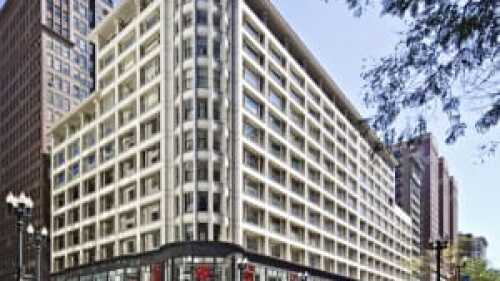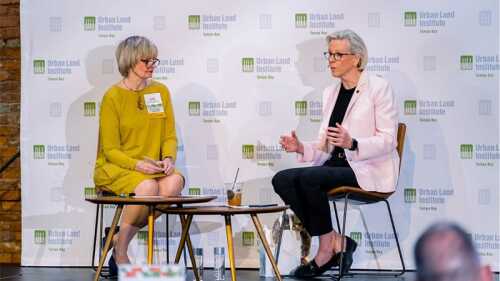Property Types
Hotels and Resorts
The Commercial Mortgage Alert Trepp weekly survey of 15 active portfolio lenders widened between October 1st and October 8th. During the period, 10-year Treasury bond yields widened by 17 basis points, with average all-in cost equal to equal to 4.80 percent.
As the hospitality industry starts to recover from the low point it reached over the past couple of years, some trends have emerged that show changes in consumer preferences -- particularly at the ultra-luxury level -- that will likely dominate the industry for years to come. Read about the trends in hospitality planning and design as laid out by experts from Solage Hotels & Resorts; The West Paces Hotel Group; and, Marriott International, Inc.
The Commercial Mortgage Alert Trepp weekly survey (below) of 15 active portfolio lenders widened between September 24th. During the period, 10-year Treasury bond yields declined 12 basis points, with average all-in cost equal to equal to 4.76 percent.
Industrial
Though London’s economy has been hit hard by the global recession, the city stands firm alongside New York City and Tokyo as one of three global financial centers and remains unrivaled as the business capital of Europe.
Reuse of cargo containers as building blocks in a small Seattle hybrid commercial building helps contain costs and speed construction.
Mixed-Use
Rhode Island Row —a 2012 winner of a Terwilliger Center’s Jack Kemp Workforce Housing Models of Excellence Award—exemplifies Ron Terwilliger’s vision of mixed-income housing, which he considers the only viable solution to address the shortage of affordable housing near transit and employment hubs.
Located on a 3.18-acre (1.3 ha) one-block site in the Hyde Park neighborhood on Chicago’s South Side, Harper Court is a mixed-use project initiated by the city of Chicago and the University of Chicago.
Sullivan Center is a complex of nine historic structures in downtown Chicago that have been renovated and repositioned for modern uses.
Multifamily
Talk of a true urban “transformation” tends to carry more weight when it comes from a former police chief-turned-mayor speaking at a reinvented former trolley warehouse. The mayor of Tampa, Florida, Jane Castor, greeted attendees at a recent ULI Tampa Bay conference at the brick-walled Armature Works project.
First movers on using mass timber for both structural and design elements are seeing a growing wave of projects lining up before them. The regulatory environment is also adapting while the business model is expanding.
An area in Midtown Miami, split between the Wynwood and Edgewater neighborhoods, will be the study site for the 18th annual ULI Hines Student Competition.
Office
With roughly 58,000 people moving to the city of Tampa in 2016 alone, the region stands out as an example of accelerating U.S. growth. Water Street Tampa will give an urban facelift to Tampa’s skyline and double the downtown area in size.
Improved U.S. office market fundamentals should continue, downtown markets will receive a disproportionate amount of new supply, the tech sector likely will remain a primary demand driver, and occupiers will pursue space efficiency and agility this year, according to a CBRE report.
The highly coveted second corporate headquarters of e-commerce giant Amazon.com would be a welcome addition to Austin, but the $5 billion project undoubtedly would produce more housing and transportation woes in one of the fastest-growing regions of the United States, said panelists at a ULI Austin event.
Residental
Advances in technology and connectivity along with the identification of best practices by a collaboration of IT firms, homebuilders, and home product companies are delivering smart home platforms that are more user friendly than ever.
For those who invest in real estate in the Golden State, it makes sense to ask where the greatest need for investment lies. The most pressing need is arguably for additional housing close to jobs, which therefore represents the most interesting opportunity for investors.
The Minneapolis/Saint Paul metropolitan area is a prime example of how strong employment growth is putting a strain on the housing supply available in many U.S. cities. Since 2000, the number of Twin Cities households that face a housing cost burden—defined as spending more than 30 percent of their income on housing—has increased by 25 percent to a total of 199,000 households as of 2015, according to the Metropolitan Council.
Retail
For decades, civic leaders have tried to revitalize Market Street, San Francisco’s central thoroughfare, only to see their efforts founder. “I sometimes call it the great white whale of San Francisco,” says Eric Tao, managing partner at L37 Development in San Francisco and co-chair of ULI San Francisco. “Every new mayor, every new planning director, every new economic development director has chased that white whale.” This year, however, an international competition of ideas hosted and run by ULI San Francisco, with support from the ULI Foundation, generated fresh momentum for reimagining the boulevard. The competition drew 173 submissions from nine countries and sparked new conversations about the future of downtown San Francisco.
The OAK project began in 2009, when a development firm set their sights on the corner of Northwest Expressway and North Pennsylvania Avenue, the state’s most important and busiest retail intersection. As the region’s only parcel capable of supporting a vertically integrated project of this scale and density, that land represented an opportunity to create something truly special.
As aging retail continue to evolve, one increasingly popular trend has been to redesign malls as town centers—recalling a time when such commercial districts were the heart and soul of a community. Mall–to–town center retrofits are emerging throughout the nation, especially in suburban communities, where pedestrian-friendly, mixed-use environments are highly attractive to millennials now raising families.














